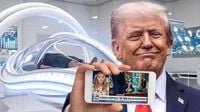On the evening of September 27, 2025, the internet lit up with a new controversy involving former U.S. President Donald Trump. This time, the buzz wasn’t about policy, campaign rallies, or a court appearance, but rather an AI-generated video that Trump shared on his Truth Social account. The video, which was quickly deleted, showcased Trump promoting a supposed breakthrough in medical technology: the so-called "medbeds." The story behind the video—and the wild claims it contained—has since sparked debate, ridicule, and renewed focus on the power of conspiracy theories in American life.
Let’s start with what actually happened. According to The Verge and France 24, Trump posted a slickly produced, AI-generated video styled as a Fox News broadcast. In the video, Trump’s daughter-in-law, Lara Trump, appears as the host, introducing a segment about a "historic new healthcare system". The segment promised every American their own "medbed card," granting access to futuristic hospitals equipped with these miracle beds. The AI-generated Trump declared, “You’ll have guaranteed access to our new hospitals led by the top doctors in the nation, equipped with the most advanced technology in the world. These facilities are safe, modern and designed to restore every citizen to full health and strength.” The video even claimed that only a limited number of cards would be available in the first phase, adding a sense of urgency and exclusivity.
But there was one big problem: none of it was real. Fox News quickly denied any involvement, telling The Verge that the segment “never aired on Fox News Channel or any other Fox News Media platforms.” There has been no official announcement from the White House, past or present, about medbeds or any similar healthcare initiative. The video, it turns out, was entirely AI-generated and based on a conspiracy theory that has been circulating in far-right QAnon circles for years.
So, what exactly are "medbeds"? According to BBC, Snopes, and India Today, medbeds are a central feature of a conspiracy theory that claims governments and shadowy elites are hiding advanced machines capable of reversing aging, curing deadly diseases, and even regrowing lost limbs. Supporters of the theory say these devices work through technologies like quantum energy, terahertz light, or artificial intelligence—sometimes even suggesting the machines are of alien origin. Some of the more outlandish claims include the idea that John F. Kennedy Jr., who died in 1999, is alive today thanks to a medbed. Others believe that the so-called “deep state” and billionaires are keeping these miracle machines from the public to protect pharmaceutical profits.
The medbed myth didn’t start with Trump’s video. As France 24 and Snopes report, it has been a fixture in QAnon communities and fringe forums for years, often spreading through Facebook groups that charge hefty membership fees for "insider access." Some groups even sell fake "medbed cards"—like those promised in Trump’s video—or makeshift devices marketed as health boosters. India Today points out that companies like Tesla BioHealing sell wellness machines for over $11,000, but these products come with disclaimers stating they are not intended to diagnose, treat, or cure any disease. In August 2023, the FDA sent Tesla BioHealing a warning letter for making unproven medical claims, leading the company to scrub references to serious illnesses from its website.
Despite the lack of scientific evidence, the allure of a cure-all technology persists. Health experts and disinformation researchers are unanimous in their assessment: medbeds are pure pseudoscience. “It’s really hard to define something that doesn’t exist,” one analyst told the BBC. Jonathan Jarry, a science communicator at McGill University, echoed this sentiment in August 2025, writing, “No one has an actual photo of a med bed because they don’t exist.” The explanations of how medbeds supposedly work vary wildly, but they all share the same foundation of pseudoscientific jargon and wishful thinking.
Even the so-called "medbed cards"—which Trump’s video claimed would guarantee access to these miracle hospitals—are a sham. Snopes discovered that companies selling such cards, sometimes for as much as $447, only offer things like exclusive information about terahertz technology, discounts on unrelated products, and personalized email offers. As Snopes dryly noted, “The MedBed Card has no other function or meaning beyond the benefits listed above.” In some cases, buyers of supposed medbed products have posted videos showing they received nothing more than cement inside the packaging.
The viral video wasn’t just a harmless oddity; it reignited belief in the medbed conspiracy and sent waves of confusion across social media. As France 24’s Charlotte Hughes reported, Trump’s post “injected new life into a long-held conspiracy theory about ‘med beds’, which is prominent in far-right QAnon circles online.” Snopes noted a surge in reader questions about whether medbeds were real following the post. CNN anchor Jake Tapper addressed the issue directly, explaining, “Medbeds are a conspiracy theory popular with QAnon people, in which there exists these magic beds, which restore limbs and reverse aging and cure anything that befalls the human body, but they're only available to the rich and the elite.”
Late-night hosts weren’t about to let the moment pass, either. NBC’s Seth Meyers joked on air, “Trump seems like the kind of guy who would watch an AI video of himself and then demand his staff explain why they didn’t tell him about the thing he obviously already knows about.” Meyers continued, “That’s right, Trump shared a fake video about a secret healing technology called a medbed. And my question is, if medbed exists, why hasn’t Trump used one?” The ridicule underscored a larger point: the willingness of public figures to promote or fall for conspiracy theories can have real-world consequences for public trust in science and medicine.
This wasn’t the first time Trump has promoted dubious medical claims. In the same week, he pushed another widely debunked theory, suggesting a link between pregnant women taking Tylenol (acetaminophen) and autism. Stumbling over the word “acetaminophen” during a press conference, Trump said, “Which is basically commonly known as Tylenol. During pregnancy, can be associated with a very increased risk of autism. So, taking Tylenol. Is… ahhh… Not good.” Medical experts and regulators have repeatedly found no credible evidence to support this claim, but it continues to circulate in some corners of the internet.
The medbed episode is a telling snapshot of the current information landscape. A single, AI-generated video—shared and then deleted by a major political figure—managed to stoke an old conspiracy theory, prompt mainstream media debunkings, and inspire both mockery and concern. In a world where misinformation can travel faster than ever, the need for skepticism and critical thinking has never been more urgent.
As the dust settles, one thing is clear: medbeds remain a fantasy, not a medical breakthrough. But the story of their viral resurgence is a potent reminder that in the age of AI and social media, separating fact from fiction is more challenging—and more important—than ever.

